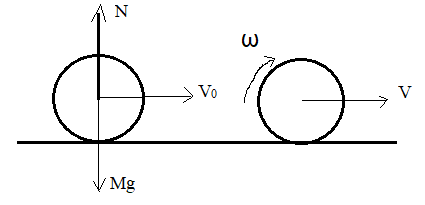
Concept explainers
(a)
The distance moved by the ball
(a)
Answer to Problem 101P
Explanation of Solution
Given: Mass of the ball is
Radius of the ball is
The coefficient of kinetic friction between the ball and the floor is
At the instant the ball touches the floor it is moving horizontally with a speed
Formula used:
Velocity
Equation of kinematics
Where,
Calculation:

FIGURE:
In the figure
N is the normal reaction force which is acting in the upward direction through the point of contact.
Velocity
In this problem there arise a force of kinetic friction,
This acceleration is in the direction opposite to the direction of motion of the ball and hence equation
The horizontal force
Where,
Thus, the equation
Angular acceleration,
This angular acceleration sets the ball rotating with angular velocity
When the ball starts rolling, the velocity
is satisfied.
Substituting equation
Substituting for
Substituting the expression for
Substituting the value of
The distance moved by the ball
Using the equation
Substituting the expressions for
Conclusion:
The distance moved by the ball before it begin to roll without slipping is
Time taken by the ball to cover the distance
The final speed of the ball is
(b)
The ratio of the final kinetic energy to the initial kinetic energy of the ball.
(b)
Answer to Problem 101P
Explanation of Solution
Given: Mass of the ball is
Radius of the ball is
The coefficient of kinetic friction between the ball and the floor is
At the instant the ball touches the floor it is moving horizontally with a speed
Final velocity of the ball is
Formula used:
The final kinetic energy of the ball is given by,
Where,
Initial kinetic energy of the ball is given by,
Calculation:
Moment of inertia of the ball is given by,
For rotational motion of the ball the velocity,
Substituting for
But,
Therefore final kinetic energy of the ball is,
From equations
Conclusion:
The ratio of the final kinetic energy to the initial kinetic energy of the ball is
(c)
The values of
(c)
Answer to Problem 101P
Explanation of Solution
Given:
Formula used:
Calculation:
Substituting the numerical values in equation
Substituting the numerical values in equation
Substituting the numerical values in equation
Conclusion:
The values of
Want to see more full solutions like this?
Chapter 9 Solutions
PHYSICS F/SCI.+ENGRS.,STAND.-W/ACCESS
- Describe the motion of a charged particle entering a uniform magnetic field at an angle to the fieldlines. Include a diagram showing the velocity vector, magnetic field lines, and the path of the particle.arrow_forwardDiscuss the differences between the Biot-Savart law and Coulomb’s law in terms of their applicationsand the physical quantities they describe.arrow_forwardExplain why Ampere’s law can be used to find the magnetic field inside a solenoid but not outside.arrow_forward
- 3. An Atwood machine consists of two masses, mA and m B, which are connected by an inelastic cord of negligible mass that passes over a pulley. If the pulley has radius RO and moment of inertia I about its axle, determine the acceleration of the masses mA and m B, and compare to the situation where the moment of inertia of the pulley is ignored. Ignore friction at the axle O. Use angular momentum and torque in this solutionarrow_forwardA 0.850-m-long metal bar is pulled to the right at a steady 5.0 m/s perpendicular to a uniform, 0.650-T magnetic field. The bar rides on parallel metal rails connected through a 25-Ω, resistor (Figure 1), so the apparatus makes a complete circuit. Ignore the resistance of the bar and the rails. Please explain how to find the direction of the induced current.arrow_forwardFor each of the actions depicted, determine the direction (right, left, or zero) of the current induced to flow through the resistor in the circuit containing the secondary coil. The coils are wrapped around a plastic core. Immediately after the switch is closed, as shown in the figure, (Figure 1) in which direction does the current flow through the resistor? If the switch is then opened, as shown in the figure, in which direction does the current flow through the resistor? I have the answers to the question, but would like to understand the logic behind the answers. Please show steps.arrow_forward
- When violet light of wavelength 415 nm falls on a single slit, it creates a central diffraction peak that is 8.60 cm wide on a screen that is 2.80 m away. Part A How wide is the slit? ΟΙ ΑΣΦ ? D= 2.7.10-8 Submit Previous Answers Request Answer × Incorrect; Try Again; 8 attempts remaining marrow_forwardTwo complex values are z1=8 + 8i, z2=15 + 7 i. z1∗ and z2∗ are the complex conjugate values. Any complex value can be expessed in the form of a+bi=reiθ. Find θ for (z1-z∗2)/z1+z2∗. Find r and θ for (z1−z2∗)z1z2∗ Please show all stepsarrow_forwardCalculate the center of mass of the hollow cone shown below. Clearly specify the origin and the coordinate system you are using. Z r Y h Xarrow_forward
- 12. If all three collisions in the figure below are totally inelastic, which will cause more damage? (think about which collision has a larger amount of kinetic energy dissipated/lost to the environment? I m II III A. I B. II C. III m m v brick wall ע ע 0.5v 2v 0.5m D. I and II E. II and III F. I and III G. I, II and III (all of them) 2marrow_forwardCan you solve this 2 question teach me step by step and draw for mearrow_forwardFrom this question and answer can you explain how get (0,0,5) and (5,0,,0) and can you teach me how to solve thisarrow_forward
 Principles of Physics: A Calculus-Based TextPhysicsISBN:9781133104261Author:Raymond A. Serway, John W. JewettPublisher:Cengage Learning
Principles of Physics: A Calculus-Based TextPhysicsISBN:9781133104261Author:Raymond A. Serway, John W. JewettPublisher:Cengage Learning Physics for Scientists and Engineers: Foundations...PhysicsISBN:9781133939146Author:Katz, Debora M.Publisher:Cengage Learning
Physics for Scientists and Engineers: Foundations...PhysicsISBN:9781133939146Author:Katz, Debora M.Publisher:Cengage Learning University Physics Volume 1PhysicsISBN:9781938168277Author:William Moebs, Samuel J. Ling, Jeff SannyPublisher:OpenStax - Rice University
University Physics Volume 1PhysicsISBN:9781938168277Author:William Moebs, Samuel J. Ling, Jeff SannyPublisher:OpenStax - Rice University Physics for Scientists and Engineers, Technology ...PhysicsISBN:9781305116399Author:Raymond A. Serway, John W. JewettPublisher:Cengage Learning
Physics for Scientists and Engineers, Technology ...PhysicsISBN:9781305116399Author:Raymond A. Serway, John W. JewettPublisher:Cengage Learning Classical Dynamics of Particles and SystemsPhysicsISBN:9780534408961Author:Stephen T. Thornton, Jerry B. MarionPublisher:Cengage Learning
Classical Dynamics of Particles and SystemsPhysicsISBN:9780534408961Author:Stephen T. Thornton, Jerry B. MarionPublisher:Cengage Learning Glencoe Physics: Principles and Problems, Student...PhysicsISBN:9780078807213Author:Paul W. ZitzewitzPublisher:Glencoe/McGraw-Hill
Glencoe Physics: Principles and Problems, Student...PhysicsISBN:9780078807213Author:Paul W. ZitzewitzPublisher:Glencoe/McGraw-Hill





